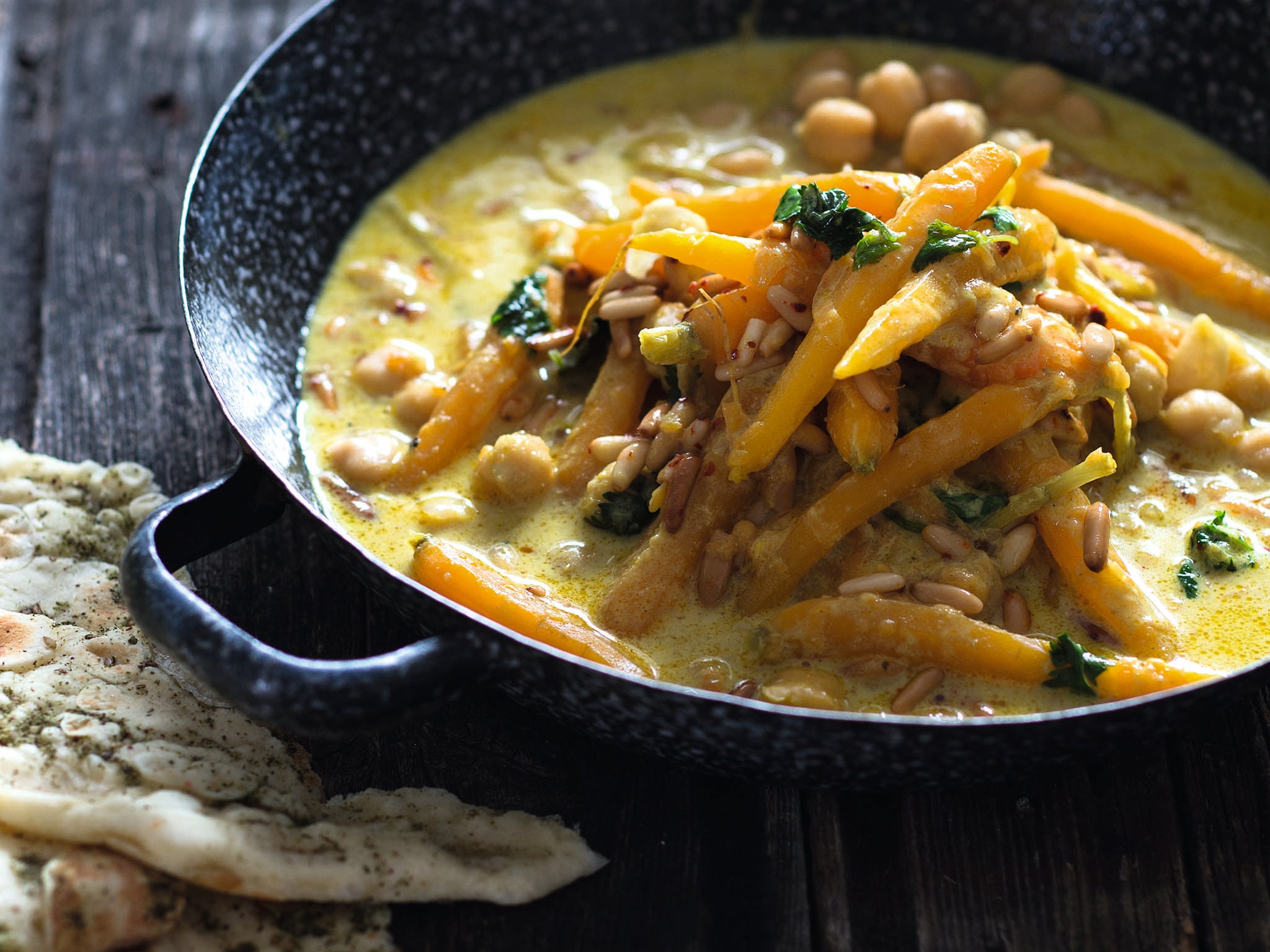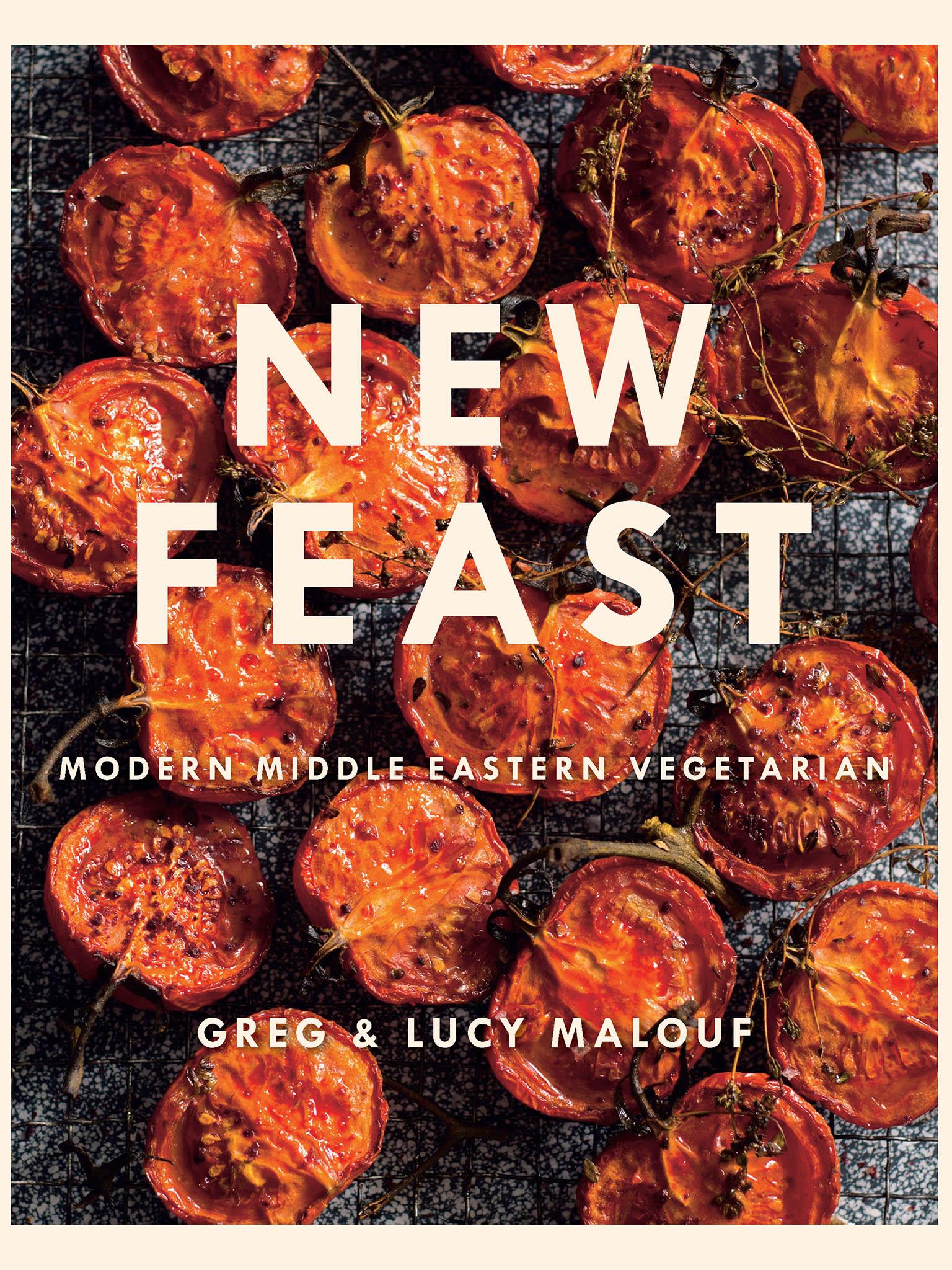Three recipes from Greg and Lucy Malouf's New Feasts cookbook
After cutting down on meat and eating more plants in a bid to reduce their excess lifestyles, the cooking duo use the food of Greg's Lebanese heritage to create and eat a less gluttonous diet

Baby carrot tagine with yoghurt and honeyed pine nuts
This unusual, subtly sweet and spicy carrot tagine is made wonderfully rich and tangy with the last-minute addition of yoghurt. Serve it with plain buttered couscous or mixed spring greens with golden raisins. It is also delicious with long-grain rice with lemon and toasted almonds.
Serves 4
40ml olive oil
Generous knob of butter
1 large onion, finely grated
1 large carrot, finely grated
2 cloves garlic, finely grated
1tsp ground cumin
1tsp ground coriander
½tsp turmeric
½tsp finely ground black pepper
1tbsp honey
400g tin chickpeas, well rinsed and drained
400g baby (or Dutch-style) carrots, with tops attached
600ml vegetable stock
200g natural yoghurt
1tbsp cornflour
1 egg yolk
Handful coriander leaves
Honeyed pine nuts
1tbsp butter
1tbsp honey
60g pine nuts
Good pinch salt
Preheat the oven to 180C. Heat the oil and butter in a large flame-proof casserole. Add the grated onion and carrot, the garlic, spices and honey. Saute over a low heat for about 10 minutes, or until the onion is soft and translucent and the carrot is meltingly soft. Add the chickpeas and whole baby carrots, then pour in the stock. Bring to the boil, then lower the heat, cover the pan and cook in the oven for 30 minutes.
Remove the tagine from oven and transfer it to the stovetop over a medium heat. In a small bowl, whisk the yoghurt with the cornflour and egg yolk. Add a big spoonful of the tagine cooking liquid to the yoghurt and stir it in well. Tip the yoghurt into the tagine, bring to a simmer and cook, stirring, until the sauce thickens slightly. Heat the butter and honey over a medium heat in a small frying pan. When the butter has melted, add the pine nuts and salt and fry for about two minutes until they turn golden brown. Stir the coriander leaves into the tagine. Drain the pine nuts and sprinkle on top of the tagine as you serve it.

Pumpkin kibbeh stuffed with feta and spinach
This is a vegetable version of the famous torpedo-shaped kibbeh, so beloved by Lebanese restaurants. In Greg’s family, as is common in Middle Eastern Christian communities, vegetable kibbeh are often served during Lent, when people reduce their meat consumption. They are most often made with mashed potato, but we find that butternut squash works beautifully as well.
When it comes to the filling, be as imaginative as you like. Use the spinach mixture below as a base and add other flavours, depending on what you have to hand. We’ve been known to use feta, halloumi, goat’s cheese or mozzarella, as well as flavoured butters (recipes for these on pages 55-56 of the book).
Kibbeh shell
450g butternut squash
Salt and freshly ground black pepper
Olive oil
100g fine bulgur wheat
½ small onion, finely chopped
1tbsp tahini, well stirred
1tbsp plain flour
¼tsp ground allspice
¼tsp ground cinnamon
Greek-style yoghurt, to serve
Extra-virgin olive oil, to serve
Feta and spinach filling
1tbsp olive oil
1tbsp butter
1 small onion, finely diced
100g spinach leaves, stalks removed
Salt and freshly ground black pepper
Feta or your choice of melting white cheese or savoury butter. We especially like Persian Sabzi
Butter and harissa butter*
Make the kibbeh shell first. Preheat the oven to 180C. Cut the squash into chunks and arrange in a small roasting tin. Toss with salt, pepper and a generous splash of olive oil. Cover with foil and roast for 25-30 minutes, or until very tender. Remove from the oven and leave to cool.
While the squash is cooling, soak the bulgur wheat in warm water for five minutes. Tip into a sieve and, using your hands, squeeze out as much water as you can. Then tip into a tea towel and twist to extract even more water. When it is as dry as you can manage, tip it into a large mixing bowl.
Slice away the skin from the squash and weigh out 250g of flesh. Add it to the bowl with the bulgur wheat and mash the two together to form a smooth puree. Add the onion, tahini, flour and spices and season generously with salt and pepper. Knead with your hands until the mixture is thoroughly blended. Chill for at least 30 minutes, which will make the paste easier to work with. To make the filling, heat the oil and butter in a medium frying pan and add the onion. Sweat for 5-10 minutes, until soft and translucent. Add the spinach leaves and stir over the heat, turning it around frequently, until it wilts. Remove from the heat and leave to cool. Season with salt and pepper then chop finely.
When you are ready to make the kibbeh, divide the shell mixture into 12 even portions. Take one portion in the palm of your left hand and roll it smooth with the other hand. Using the forefinger of your right hand, make an indentation in the ball and start to shape it carefully into a hollow shell. Try to make the shell as thin and even as you can. Wet your finger from time to time, to make it easier.
Fill the shell with a scant teaspoon of the spinach filling, together with a small cube of feta or your choice of flavoured butter. Add another pinch of spinach, then wet the edges of the opening and carefully pinch it closed. Make sure you don’t trap any air inside. You are aiming to form a small torpedo-shaped dumpling, with slightly tapered ends. Repeat with the remaining mixture and filling. Leave the stuffed kibbeh on a tray in the fridge, covered, for at least 30 minutes, or up to four hours, until you are ready to cook them.
When ready to cook, pour vegetable oil into a medium, heavy-based saucepan to a depth of about 6cm and heat to 180C*. Fry the kibbeh, a few at a time, for 4-5 minutes, or until they turn a deep golden brown. Turn them around in the oil to ensure they colour evenly all over. Drain them on kitchen paper and serve piping hot with a dollop of yoghurt and a drizzle of extra-virgin olive oil.
*Note: if you don’t have a candy thermometer, the oil will have reached the correct temperature when it is shimmering, and when a cube of bread sizzles slowly to the surface and turns a pale golden brown in about 30-40 seconds.
*Harissa butter
Makes1 x 140g
1 small shallot, finely chopped
1 clove garlic, finely chopped
¼tsp salt
125g unsalted butter, softened
½tbsp red or green harissa
Combine the shallot, garlic and salt in a mortar and pound to a paste. Add to the butter and harissa and beat everything together well. Spoon onto a sheet of cling film or greaseproof paper and shape into a log. Roll up neatly, twist the ends, tie securely and chill until required. The butter will keep in a sealed container in the fridge for two weeks or up to three months in the freezer.

Persian soft herb salad with fresh figs and labneh
One of the great pleasures of our travels around Iran a few years ago was the way each and every meal began with a basket of fresh herbs – called sabzi – along with soft white cheese and warm flatbread. It’s a habit that we’ve continued to this day, as it’s a brilliant appetite-sharpening way to begin any meal. This refreshing salad is really just a more refined variation on the sabzi theme: it’s all about the freshness of the herbs and leaves that you choose – and feel free to experiment with your own selection. Similarly, try replacing the figs with cherries, white peaches or nectarines, when they are in season. Eat, Persian-style, with griddled flatbreads (recipe on page 36 of the book) or as an accompaniment to rich or filling dishes.
Serves 4-6
12 leaves red chicory, bases trimmed
125g of mixed leaves, such as watercress, chervil, pea shoots
20g basil
20g Thai or purple basil
20g mint
4 firm, but ripe, figs, peeled and quartered
3 radishes, halved lengthways
200g Labneh, strained for 12 hours
Edible flowers, such as borage, or nasturtiums, to garnish (these are pretty, but entirely optional)

Hazelnut dressing
50ml hazelnut oil
Few drops of sesame oil
50ml olive oil
30ml champagne or good-quality white wine vinegar
50ml water
Salt and freshly ground black pepper
To make the dressing, tip the oils into a bowl and whisk in the vinegar, then the water. Season with salt and pepper. For the salad, combine all the ingredients, except the labneh, in a serving bowl. Lightly season with salt and pepper and pour in as much dressing as required. Use your hands to mix everything together gently. Add blobs of labneh and flowers, if using, and serve.
New Feast: Modern Middle Eastern Vegetarian by Greg and Lucy Malouf (Hardie Grant, £20)
Join our commenting forum
Join thought-provoking conversations, follow other Independent readers and see their replies
Comments
Bookmark popover
Removed from bookmarks